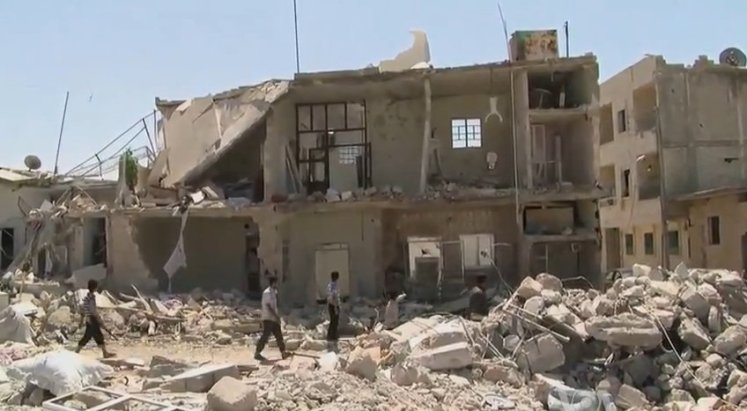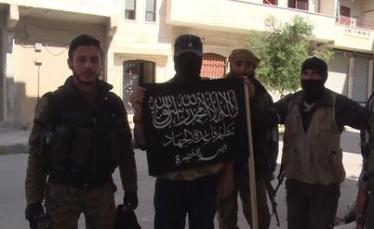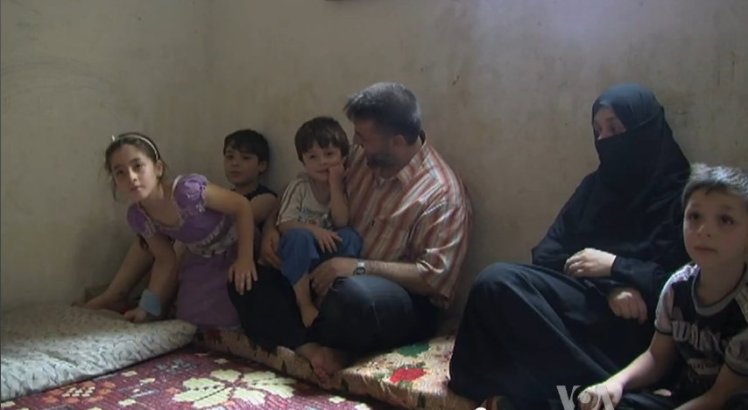Since they burst onto the scene in early 2012, their spiritual pledge to the world’s most hated people have stirred up fear and resentment, enough to divert the average American or European away from supporting the rebellion in Syria that their tactics now play a leading role in. These actions, for many, replaced iconic images of “Arab Spring” protesters with masked gunmen and explosions.
Down below is a detailed analysis on the fascinating rise and sustainability of Jabhat al-Nusra, the Al-Qaeda-linked Syrian rebel group, as authored by activist Ben Davies. Ben has spent time in Syria’s Idlib Province among the battle-scarred local population, which is rarely something that many of the world’s most formidable commentators, journalists, and politicians can claim. He brings to the table a viewpoint backed up by serious research — and he assesses it in a frank and unbiased way, at least in my opinion. You can see for yourself and be the judge.

Mind you, it’s not easy for most Westerners to fairly examine and dissect an insurgent faction that has pledged allegiance to the terrorist organization that laid waste to the World Trade Center on September 11, 2001 and obliterated 3 trains and a bus in London on July 7, 2005, among countless other depraved acts. Peering into the unfathomable Syrian nightmare, however, a dire situation is revealed where al-Nusra is actually seen by many Syrians today as a buffer between the rotating hammer and anvil of the significantly more violent Islamic State/ISIS militants and the regime of President — if it is even fair to call him that — Bashar al-Assad.
Speaking of which, I’ve examined the subject of jihadist activity in Syria and its links to Assad in the past myself, both on this website and through other mediums — debunking the ridiculous assertions by Assad’s defenders that he represents some sort of bulwark against Al-Qaeda and extremism. Nothing could be further from the truth, and Ben breaks it down further, reminding his audience of realities that everyone should be aware of. He connects the dots between Assad, ISIS, al-Nusra, and the extremism that has been injected into many of the Syrian rebels fighting to topple the government. Putting it simply, there’s plenty of blame to go around as they all were united at one time in opposition to the US occupation of Iraq post-2003.

By the way, The Arabic term “Da’esh” that Ben uses refers to the Islamic State, or ISIS — the Islamic State of Iraq and Syria, as it is commonly known in Western countries. He makes this point himself, but I will state it up front to avoid any confusion. There are A LOT of groups and factions operating in Syria today…enough to confuse even veteran followers of Middle East politics. The misguided will all too often present this ferocious conflict as some kind of epic battle pitting ISIS and Sunni Muslims (the sect ISIS claims to represent) who support them against Assad and his Iranian/Shiite Muslim backers legitimacy for political purposes) but it is far more complicated than that.
Factoring in shifting alliances, it generally has flowed as follows. 1) Assad and his army, air force and militias, backed extensively by Iran, Russia, and the Lebanon-based movement/designated terrorist organization Hezbollah 2) the Syrian rebels, backed by Turkey and Saudi Arabia, and consisting of the relatively secular “Free Syrian Army” (FSA), the Islamic Front (IF), other groups, and although there are often tensions, Jabhat al-Nusra. In some areas, Nusra has fused with the Islamic Front to form a united coalition known as “Jaish al-Fatah“, where they have achieved a stunning set of victories. Then there is 3) ISIS — which fights anyone who does not submit to the rule of its leader, Abu Bakr al-Baghdadi, under a self-declared Islamic caliphate. After that bunch, there are 4) the Kurds, a faction with throngs of Western supporters who admire their emphasis on secularism and women’s rights. They have coalesced into a militia identified by its Kurdish acronym “YPG” — meaning “People’s Protection Units”.
The rebels, ISIS, and the YPG in one way or another follow Sunni Islam, while Assad derives the bulk of his support from Shiites and the Alawites — a loose offshoot of Shi’ism of which the Syrian president is a member of. Aside from the Kurds, all factions — government and rebel — are ethnically Arab, save for the foreign fighters flooding in from around the world to join up in the fighting. And there are plenty of them, from the United States to Indonesia and beyond.
The civil war, it should be stated, began in March of 2011, when Sunni Arab and Kurdish protesters rose up in the streets against Assad and his family’s decades of rule, braving gunfire and eventually forming their own paramilitary units to respond. During at least one distinct point in the conflict, all these factions have set their guns on each other — though the bulk of the fighting over the past year has been rebels versus Assad, ISIS versus Kurds, ISIS versus Kurds AND rebels, and ISIS versus Assad for control of a few strategic bases gateways. Fighting has also flared up from time to time between Assad and the Kurds, though they have generally tried to keep a ceasefire in place. If that’s too much to remember, just think “plenty of bloodshed to go around.”
Terrible, I know. Putting the focus specifically back on al-Nusra and the future of Al -Qaeda in Syria, here is Ben’s article:
Al-Nusra Are (Probably) Here To Stay, But Must Drop the Al-Qaeda Label
When Jabhat al-Nusra announced its formation on January 23rd 2012, little was thought of it. Indeed, I recall Syrians commenting on the Guardian’s Live Blog (which covered the anti-regime uprising in detail) stating that they thought the organisation was a regime operation designed to discredit the revolution.
The truth is that although there is long-standing cooperation between Da’esh and the Assad regime, and Al-Nusra was dispatched to Syria as an offshoot of Da’esh (then the “Islamic State of Iraq” or ISI — or known at one time as Al-Qaeda in Iraq) in August 2011 by the then-obscure emir “Abu Bakr al-Baghdadi”, the two organisations have since become intense foes.
In effect, the Assad regime’s efforts to work with ISI/Da’esh to undermine the Syrian revolution backfired and helped to form Al-Nusra and other groups that would become key to its undoing across much of the country.
In 2011 Assad deliberately released thousands of “Islamist” (the author balks at using a buzzword used to brand political Muslims negatively as a whole) prisoners from his jails, so they would taint the revolution with a jihadist trend frowned upon by the West, in order to be seen as the lesser of the two evils.
Abu Muhammad al-Jolani, the Syrian who had risen through the ranks of the insurgency in Iraq prior to capture and several years of detention, linked up with several of these released men to form his new group. From October 2011 up until their founding in January of 2012, they met to establish the objectives of al-Nusra.
Once the group was formally established it grew rapidly; not only did al-Nusra have the cash and arms that most armed groups craved, but it had impeccable organisation and a strong command structure, resulting in a highly disciplined force.
Added to the mixture was a lethal cocktail of mujahideen; horrified by Syrian military atrocities, Muslims from around the globe flocked to join Islamic groups; some came from as far afield as Britain, others from around the Middle East. The charismatic Sheikh Abdullah al-Moheisany from Saudi Arabia is currently a field commander, and a popular internet personality..
Throughout the second half of 2013, the seemingly unstoppable ascendency of the Nusra Front was challenged. ‘Islamic State of Iraq’ emir Abu Bakr Al-Baghdadi released a recording on April 8th in which he proclaimed that the front was their creation and had been funded and supported by his group. He announced that al-Nusra would be merge with ISI to form the Islamic State of Iraq and Ash-Shaam (ISIS).
Jolani responded the next day by affirming that al-Nusra considered themselves to be a part of al-Qaeda, but flatly rebuffed Baghdadi: “Neither the al-Nusra command nor its consultative council, nor its general manager were aware of this announcement. It reached them via the media and if the speech is authentic, we were not consulted.”
At this point, ISI (now ISIS) was expanding steadily into Syria over the porous Iraqi borders through Deir Ezzor, using a combination of subterfuge, assassination and cooperation with the regime. Their ultimate plan, devised by de-facto leader Samir al-Khlifawi, was to take control of Syria and use it as a beach-head to conquer Iraq.
Many more extreme foreign fighters in al-Nusra deserted for them, obeying Baghdadi’s command. Baghdadi personally travelled to Syria to try and take control of al-Nusra. In May, al-Qaeda emir Ayman al-Zawahiri ordered Da’esh to leave Syria and appointed an emissary to reconcile the two. Bagdadi, although still ostensibly part of al-Qaeda rebuffed the order, causing much confusion.
By late-2013, although ostensibly united in the fight against the regime, Da’esh and the revolutionary factions, including al-Nusra, were increasingly hostile to each other.
Da’esh fanned out from Deir Ezzor until they controlled territory in Idlib and Aleppo, using crossings to bring in young, zealous idiots (to be frank) from around the world, knowing their lack of ties to the population would make them more willing to kill. Their harsh treatment of Syrians and deeply foreign character created immense resentment, as did their deliberate focus on other factions and unwillingness to attack the regime, as part of the unofficial cooperation agreement.
In September 2013 Da’esh attacked the FSA-controlled border town of Azaz and took control of it, expelling the Northern Storm Brigade (to the approval of the regime) and the crucial Bab al-Salameh border crossing. In November they captured Atme. In December 2013 Doctor Hussein Suleiman’s tortured body was recovered from the group.
You can read the rest of Ben’s commentary here.

Providing my own commentary, I’ll say that al-Nusra itself, having successfully expelled both Assad forces and ISIS from areas its shares with rebels, is definitely at a crossroads in terms of its identity and how it will treat the Syrian citizens it governs in the future — I believe Ben is completely correct by saying this. But with Assad still holding on in the capital, Damascus, and along the coast where his Alawite supporters form a majority — and an invasion of his Russian allies deploying to protect him — Sunni extremism is set to grow in Syria, and with that, it’s hard to say where it will lead. Sunnis feel betrayed by the West, who seem to have abandoned their calls for Assad to step down and have even shown that they were never really serious about the dictator’s departure in the first place. With little to lose, they will therefore be more reluctant to moderate, even if CIA predator drone missiles rain down on them.
The United States has royally blundered every opportunity it had to project positive influence in Syria, the latest being its attempt to train several dozen rebels, convince them to fight ISIS instead of Assad, and then march them back across the border through al-Nusra controlled territory. This gambit failed, and the rebels, unsurprisingly, threw in with al-Nusra — certainly a major embarrassment, unless President Obama wants to push them toward Al-Qaeda as a justification for extending his budding relationship with Iran, Assad, and the Shiite militias.
Theoretically, it’s not over though…not just yet. Real leadership could involve reaching out to the FSA and IF rebels aligned with the Kurdish YPG militia, who are controlling some 50 cities, towns, and villages across three Syrian provinces, side by side together (see the map here, and look at the top 3 provinces where mixed green and yellow circles dot the landscape). Kurds, being excellent in their intelligence gathering, could receive and distribute weaponry from Western sources — and in exchange for this, might be willing to ditch their tacit ceasefire and occasional cooperation with the Syrian regime in the far east (where the regime controls a few stations and city blocks) and effectively end its presence there for good.

With a joint command between Syrian FSA/IF and Kurds, backed by weaponry (received and distributed by the Kurds, as well as perhaps vetted FSA) for use against Assad and air strikes against ISIS, Syria could become as close to stabilized as possible– and with the two devils out of the way, al-Nusra would have to make its choice between throwing in with the people or staying true to its atrocious Al-Qaeda name recognition. Choosing the later, it could be contained and mopped up by venerable Kurds and rebels who reject the oppressive tenets it has sought to enforce at times.
Of course, everything I’m saying is speculation. It has become an open secret that President Barack Obama was never serious about the removal of Assad, even for all the angry theories suggesting he’s out to get the Syrian dictator. Obama’s goal from the beginning has been a deal with the Islamic Republic of Iran, Assad’s leading ally. Getting rid of him was and is antithetical to that accomplishment.
Should a new president with a different mindset come to power in 15 months, the actions described above might happen. Others will inevitably argue — perhaps to a growing chorus — that the US shouldn’t be involved at all, that it’s none of America’s business, or that it should simply let Iran, Russia, ISIS, and al-Nusra bog themselves down in perpetual warfare over Assad’s fate.

Regardless of which path is taken, it remains to be seen just how different the geopolitical landscape of the Middle East will be by the time Obama leaves — and what devastating repercussions, whether in the form of terrorism, mass killings, or waves of mass migration it might have on the rest of the planet.
How do you feel about the idea that the US or the Western nations could have thwarted Nusra’s rise by giving aid to the “moderates” earlier, in large quantities? Was it inevitable for AQ to get involved no matter what?
Honestly, I’ve never been convinced that the West, including the United States, cared about seeing Assad go. For all this talk about how Obama has some sort of vendetta against Assad, rebel groups have received little support militarily, and weaponry that could turn the tide in the skies — where Assad is committing his worst massacres and holding onto power — has been completely out of the question. At most I believe the Obama Admin may have wanted to weaken Assad’s regime as leverage with Iran for a “deal”.
Speaking (typing) of which, the primary benefactor of the US lately has been Iran, a recipient of billions of dollars in assets (linked to in the above article) with billions more on the way, along with coveted international legitimacy. Couple that with the massive US arms dumps being poured into Iraq, where the Revolutionary Guard has that country in a stranglehold, and subsequently into the hands of allied Shiite militias. Don’t forget that the US Air Force has been targeting Assad’s enemies (Nusra, IF) too…without firing a shot at his aircraft at any time during a yearlong bombing campaign.
That’s the way I see it, at least. As for AQ/affiliated groups involvement, they tend to appear anywhere a vacuum breaks out in this part of the world, with or without the West. Iraq, Yemen, Mali, Libya, Nigeria, and Cameroon are just a few examples. Syria became violent, then became a power struggle, and thus AQ came along.